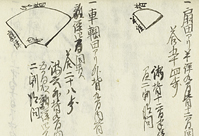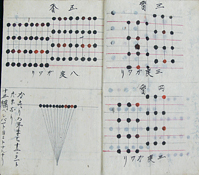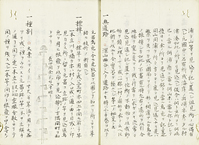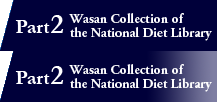Chapter 4. Wasan as a Practical Science
The previous chapter covered Wasan as playful pursuit or a hobby, but here we would like to emphasize that not all the mathematicians in the Edo period indulged in studying mathematics as a game. One aspect of Wasan indeed approached mathematics as a game, but that was only half of the nature of Wasan.
So, what was the other half of Wasan? The answer is its practical science aspect of mathematics as was required in the society in those days. As we described in Chapter 1, many Wasan scholars approached other things such as creating maps or calculating calendars. Every society needs maps and calendars. Wasan scholars were keenly aware that Wasan could be applied to their creation. They were desperately seeking meaning in their activities for society. In a period when there was a die-hard trend of arithmetic being regarded as useless and the view that such things as sorobans should be relegated only to merchants, Wasan scholars tried to find every possible opportunity to promote the idea that arithmetic was useful and indispensible for society.
(1) Practical science
What was included in the practical science was not only the creation and calculation of maps and calendars; Wasan scholars also engaged in practical activities in fields closer to people's daily lives.
Agriculture, forestry and fishery
Basically, Japan in the Edo period depended heavily on agriculture, fishery, and forestry. Particularly, various items of knowledge and expertise had been applied to the management of paddy fields that had to be maintained by the continual application of manual labor. The securing and management of agricultural water was also a field of activity in which Wasan scholars engaged as an opportunity to apply their knowledge. For example, there was a Wasan scholar called Takeuchi Tadamichi in the Shinano district in the beginning of the nineteenth century; and it is known to us that he designed waterwheels to draw agricultural water and instructed carpenters onsite in response to requests from the neighboring villages. In the last days of the Tokugawa regime a Wasan scholar Hikosaka Noriyoshi from the Mikawa district collected information on the latest pumps and developed a plan to introduce them to the agricultural lands east of Mikawa, based on a request from the Toyohashi Domain. As these examples indicate, those whom people depended on in such situations were the Wasan scholars in each district.
-

Describes civil engineering work methods.
Library of Sanpo fushin tebikishu
Sanpo fushin tebikishu
NDL Digital Collections
Shogunate Tenmonkata (office in charge of compiling the calendar, astronomical measurements, surveying, translating Western books, etc.)
Turning now from the countryside to the capital, the Shogunate Tenmonkata, or the astronomical observatory organization held by the shogunate government, was originally only responsible for creating annual calendars every year; however, later it extended the scope of its activities from the nineteenth century. As we will describe later, the Shogunate brought human resources who could read Dutch to the organization and ordered its members to translate overseas matters or to perform other tasks (later, other departments such as the Banshowagegoyo (translation department) were derived from this organization). The Tenmonkata members who were both Wasan scholars and calendar researchers had plentiful opportunities to experience Western mathematics through the process of introducing Western astronomy, in addition to such special tasks. we will introduce Western mathematics in the next chapter; it is revealed that they also recognized it as useful for practical science. As long as a kind of mathematics is useful for societies, it ought not to be discriminated against, regardless of whether it is of Japanese or Western origin. There were actually Wasan scholars who approached the introduction of Western mathematics with such awareness, but they were few in number.

Observatory in Asakusa from "Fugaku hyakkei"
The electronic exhibition "Calendars in Japan"
Bureaucrats
Viewing practical science from the standpoint of bureaucrats, supervising civil engineering construction work, levy tasks, etc., was regarded as practical work that used arithmetic to its full capacity. General speaking, the civil administration in rural areas came to be called jikata (meaning rural areas), while the term jikata sanpo (rural area arithmetic) was used because it was related to the rural areas. Some tasks such as the conversion of customs, methods of land surveying, methods of building banks, and maintenance and management of water routes were selected as applications of arithmetic, and many books on these matters were published in the last days of the Tokugawa regime.
- Column Pythagorean Theorem (Level 2)

Copies of calculations of areas of agricultural lands
Library of Kenchi sanpo hihon
Kenchi sanpo hihon
NDL Digital Collections
Craftsmen
In the world of craftsmen, there was also a move to apply Wasan-like knowledge. Typical examples include the calculation of craftsmen's labor, and there appeared a scheme to digitize and record the patterns woven into a cloth in the textile industry.
-

Volume for depicting woven patterns, which were improved after the Meiji era, with an array of vertical and horizontal strings.
Lager image for Bijutsukai kairyo kasuriori meisaibo
Bijutsukai kairyo kasuriori meisaibo (owned by the University of Electro-Communications)
(2) Knowledge base in the rural areas
In the previous chapter, we explained that Wasan masters opened juku schools across the country to provide Wasan education. Wealthy farmers in the rural districts shouldered a significant number of the juku schools that formed bases for Wasan in the rural rather than urban areas. We could list a number of Wasan scholars and practitioners of Wasan from among the wealthy famers in eastern Japan as well as in western Japan. For example, Chiba Tanehide (1775-1849) from the Ichinoseki Domain was appointed from kimoiri-yaku (village headman) to the status of samurai in the domain, and greatly contributed to Wasan education in the area. Ishiguro Nobuyoshi (1760-1836) from the Toyama Domain also played an active role in Wasan education and cartography. In Okayama Domain, there was Ono Mitsuemon (1785-1858), who was not only a man of influence in the area, but also enthusiastically dealt with Wasan education. In addition to these people, many wealthy farmers & Wasan scholars supported the education and practice of Wasan. It was they or the broader class of wealthy farmers that played the major role in the diffusion of the knowledge of arithmetic required for their villages.
Let us cite a good example. At the beginning of the nineteenth century, Ino Tadataka (1745-1818) walked all around Japan to draw a map of the whole nation; his surveying could never have been accomplished only by his surveying team that he had brought from Edo. Only because there were cooperators who knew basic surveying techniques and the local geography in every area he visited, could the map have been created so rapidly. Ishiguro Nobuyoshi, whom we just mentioned, met with Ino Tadataka when he visited Toyama Domain, and guided him through the local geography. If it had not been for a certain level of accumulated knowledge of surveying and Wasan in each area, the mapping by Ino would have been more difficult to produce. The knowledge of arithmetic and Wasan in a broad sense including surveying, calendar calculation, etc., made these practical activities possible.
- Column Survey Methods (Level 0)

Book written by a Wasan scholar in Kanazawa which transmits Chokenjutsu (surveying technique) to Ishiguro Nobuyoshi
Library of Kokuzu keiyo
Kokuzu keiyo by Miyai Yasuhiro
NDL Digital Collections


